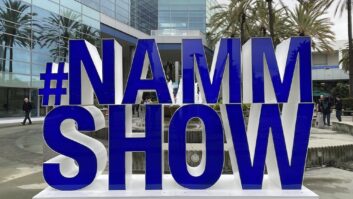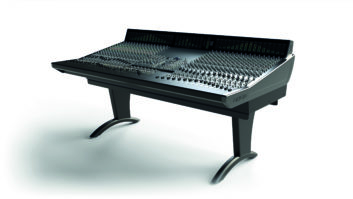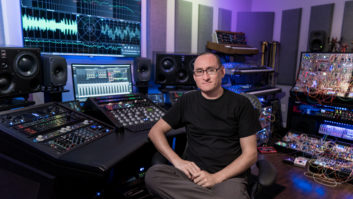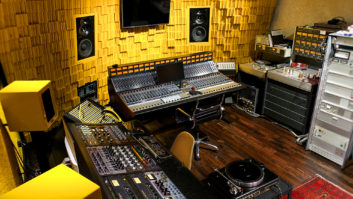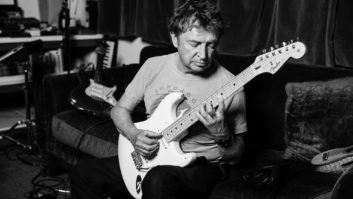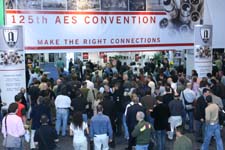
Never mind the economic doom and gloom! Returning to San Francisco from October 2 to 5, this year’s AES show saw huge numbers—more than 400 exhibitors and nearly 18,000 attendees—and hundreds of product debuts, proving it’s still the top trade show for high-performance pro audio technology.
AES was certainly a place for community, from engineers to educators to retail buyers. “We gather together to discuss the issues that impact on our individual business concerns and on the industry as a whole,” said Paul Gallo, Executive Director of the Professional Audio Manufacturers Alliance. “The AES represents the full diversity of the pro audio community. Manufacturers, engineers and end users all interface in the familial atmosphere. From recording to broadcast to video games and sports coverage, audio permeates our society. We are extremely fortunate to share an annual event of this depth and scale.” On the education side, the show hosted a wealth of events, from the inaugural METAlliance education summit to a daylong live sound symposium. A rich array of panels and workshops focused on everything from game audio to The Beatles.

On the show floor, one of the themes at this year’s show had to be the resurgence in analog—from the fact that ATR’s Master Analog tape beat out plenty of worthy competitors for the “recording devices” TEC Award to the sheer amount of analog gear on the floor (and not just in “boutique row”). But just because analog was hot, doesn’t mean digital wasn’t—as evidenced by the throngs packed in at demos of the latest workstations. Here are some of our technology highlights from AES. [For more action and on-the-scene-coverage, visit our AES video page. —Ed.]

Digidesign Pro Tools 8
DAWs March On
Digidesign’s Pro Tools 8 has a new user interface, dozens of new bundled plug-ins (including five new virtual instruments and 20 effects), fully-integrated MIDI and score editors and expanded editing features. The look features a more modern color palette and higher-contrast text and graphics, yet the key functions users rely on are right where they should be, while new touches, such as dockable Editor windows and a configurable Edit window toolbar—make it easier to navigate than ever. Pro Tools 8 software will be available in late 2008 for Windows Vista (32-bit Business or Ultimate), Windows XP- and Mac OS X 10.5 (Leopard)-based Pro Tools HD, Pro Tools LE, and Pro Tools M-Powered systems.

The flagship product in the V-Studio line of integrated hardware/software products by Roland and Cakewalk, SONAR V-Studio 700 features a dedicated control surface with nine touch-sensitive moving faders, jog/shuttle wheel, T-bar control, 20 rotary encoders/switches, surround joystick, transport controls and 70 lighted buttons. It’s paired with a two-rackspace, 24-bit/192kHz VS-700R I/O box with eight preamps, multiple digital I/Os, word clock, USB 2 and 14 analog outputs, onboard Fantom VS hardware synthesizer, DV-7 and V-link Video Control of more than 75 Edirol and Roland products—mixers, switchers, recorders, etc.—for a complete audio/video/music production system. Street price is around $4,000, with shipping in January.
The new Connie II and Connie III worksurfaces from Fairlight ports the Xynergi controller technology—formerly only available as a desktop unit—throughout the entire Constellation range. Connie II is a 2-bay Constellation mixing system configured with a 12-fader panel, Pyxis Track SD video and a new Fairlight Monitor Arm panel, while Fairlight’s Connie III takes the modular concept a stage further by providing a 3-bay Constellation mixing system configured with a 12-fader panel, Monitor Arm panel, Pyxis Track SD and three blank panels.
Jazzmutant previewed V2 of its hyper-cool Lemur multitouch controller . Lemur V2 introduces new controller objects to the graphic interface, including Gesture, an emulated trackpad with gesture recognition; Breakpoint, a multi-segment envelope editor; and Tabbed Containers, which allow you to add different page tabs to a graphic controller module. You can also use Lemur as your mouse and QWERTY keyboard for your computer. JazzEditor, the computer software that lets you set up and edit control environments for the Lemur, has also been redesigned with a cleaner, more intuitive interface.
IZ Technology’s ADA converter system features touchscreen control, 8, 16 or 24 channels of conversion and optional direct interface with Logic, Pro Tools, Neundo, REAPER and other DAWs. The upgradeable unit offers fully customizable I/O ratios, 24-bit/96kHz operation across all channels, Nyquist converter cards, MADI digital I/O standard and an optional HD card for direct interface with Pro Tools.
Plug-Ins Keep Coming
Bucking the usual see-now/ship-later trend, Universal Audio’s UAD-2 began shipping before its AES debut. The successor to its acclaimed UAD-1 Powered Plug-Ins, the UAD-2 offers three flavors of cards—Solo, Duo or Quad—providing 2.5-, 5- or 10-times the power of the original UAD-1 for tracking, mixing or mastering at sample rates from 44.1 to 192 kHz.

SPL Transient Designer plug-in
Known for its studio hardware, SPL presented its first plug-ins at AES: the Transient Designer and a series of equalizers in the Analog Code™ plug-in series. The Transient Designer and a set of three EQs (Vox Ranger, Bass Ranger and Full Ranger, based on the passive graphic equalizers of the SPL RackPack) are available as RTAS, VST and Audio Units versions. TDM versions are coming soon.
Focusrite ported its Liquid Mix technology directly to the Pro Tools HD platform, offering a variety of classic emulations including 40 compressors and 20 EQs, featuring latency of just 12 samples and more than 100 simultaneous mono instances run at 44.1/48 kHz on an HD3 system. There’s also full Control Surface Mapping for ICON and VENUE and the ability to create a unique 7-band super EQ, built out of separate classic EQ bands.
Minnetonka demo’ed the shipping version of its Dolby Media Meter plug-in for AudioTools AWE . This faster than real-time plug is designed to eliminate the annoying differences in loudness and dialog between programs, commercials or channels. The Audio Workflow Engine provides a variety of offline functions including EQ, sample rate conversion, normalization and more. The new plug-in is available directly from Dolby.
The Ozone 4 Mastering Suite from Izotope updates and expands Ozone’s processing algorithms, optimized for today’s low-latency DAW environments. Features include Intelligent Loudness Maximizer, Perfect Reconstruction crossovers, mid/side processing for superior control over the soundstage and a new True Envelope dynamics processing mode.
Sonic Studio’s NoNOISE FixIt™ combines elements of Manual DeClick™, Manual DeCrackle™, Broadband DeNoise™ and Sonic EQ™—all in one low-cost bundle. FixIt uses the same high fidelity NoNOISE II engine found in each stand-alone option, while providing a simplified user interface and entry level pricing, allowing large or small studios add high quality restoration to their service mix.
Sweet Analog Outboard
Among the bright new ideas at AES was CLASP (Closed Loop Analog Signal Processor). The brainchild of Nashville producer/engineer Chris Estes, CLASP turns your 2-inch analog deck into a tape-flavored “plug-in” for your DAW. The system consists of a hardware interface, a VST plug-in (one for every channel), and a sync cable between the box and your recorder. Just run the session from your DAW as usual and CLASP performs real-time, synched transfers from the repro head of your deck. As the entire length of a reel of tape is used, there’s no waiting for rewind while quickly shuttling between session markers in your DAW.
Solid State Logic brought old and new together with legacy modules for its X-Rack/Mynx SuperAnalogue mixing and processing system. The E Series EQ Module has two different (“Brown” and “Black”) EQs from SSL consoles produced between 1979 and 1987, with a bell curve option on HF and LF and fully parametric LMF and HMF with Q. The E Series Dynamics Module has a comp/limiter and expander/gate, both faithfully returning to the circuitry that defined the original SL 611E Series channel strip. Features include Class-A VCA replication, Expander/Gate with key input and additional switching options to defeat the over-easy curve and to use a linear release instead of the more usual logarithmic curve.
Benchmark’s slick MPA1 preamp offers a unique approach to gain control that doesn’t require a pad or gain-range switch—gain-range is controlled automatically using relay-switches when the gain-control switch passes above or below its last or first position. For real-time monitoring, the MPA1 also includes the HPA2—Benchmark’s signature high-current, 0-Ohm headphone amplifier.
Summit Audio took attendees to the “peak” of the recording front-end with its ECS-410 Everest channel strip, offering tube or solid-state preamp, three-band passive EQ and full-feature compressor with “tight” or “classic” modes. Its Drive Bus Master multiple gain stages for tube or discrete transistor output overdriving while TouchPatch gold contact relays route to/from any section at the touch of a button.
Geoff Daking represented green-minded innovators both in color and design with his Mic-Pre One, a desktop preamp featuring 70dB of gain and DI input. The box is lead-free and RoHS-compliant, adhering to restricted levels of cadmium, mercury, hexavalent chromium, polybrominated biphenyl (PBB) and polybrominated diphenyl ether (PBDE) flame retardants.
The ADAC-2, two-channel, 24-bit, 192kHz A/D, D/A and sample-rate converter from ATI Audio is a studio problem solver. All three processes can be performed simultaneously, making this a time-saver as well. Features include dedicated I/O for each converter section, front panel headphone output, intuitive pushbutton operation and an ultra-low jitter clock.

Blackmer Sound Tube E
Blackmer Sound provided a new twist on tube preamp/channel strips. Multiple gain stages in its new Tube E lets users push the signal at several saturation or overload points. Tube E also has a DI input, photonic compressor and two pads: an Iron Pad before the input transformer and a Tube Pad after the transformer. A unique Dynamic Audio Display shows clipping, gain reduction and overall signal at a glance. Other features include several shaping filters: presence contour for shimmer, tunable mid scoop filter and a Phat switch for punch.

Pearlman Church/MGM mic
Step Up to the Mic
AES continued its tradition of mics—lots of new mics. Josephson Engineering celebrated its 20th anniversary with the C720 limited edition condenser. Its dual-diaphragm capsule has two audio outs, each feeding separate XLRs, so users can tweak polar pattern variations in the mix—long after the original recording. The hand-built Bock 5-ZERO-7 from David Bock uses a patent-pending, large elliptical capsule, paired with tube electronics and a vintage-style power supply. Pearlman demo’ed its $4,500 remake of the 1950’s Stanley Church/MGM mic, created using a vintage Neumann K47 capsule and dual 6072 vacuum tube electronics. Cascade showed its C77, a $499 studio mic with a 2.5-micron-thick ribbon element, Lundahl transformer and an extended bandwidth out to 18 kHz. Blue Microphones’ new Blue Bottle Rocket Stage 1 (solid state, $899) and Stage 2 (tube, $1,999) are transformerless designs and are compatible with Blue’s Bottle Caps interchangeable capsule line.
Audio-Technica’s $749 BP4025 pairs two X/Y stereo large-diaphragm capsules with an 80Hz high-pass filter and 10 dB pad that’s perfect for high-SPL applications, such as drum overheads. The supercardioid 4099 Guitar, 4099 Sax, 4099 Trumpet and 4099 Violin instrument-mount condensers from DPA Microphones feature a fast, secure mounting system designed not to mar or scratch the finish of valuable instruments.
On the live side, Bob Heil of Heil Sound unveiled a series of interchangeable mic heads featuring his PR20, PR22 and PR 35 capsules, machined to fit Shure handheld wireless transmitters. Shipping begins in January. Telefunken USA demo’ed its $239 M 80 handheld dynamic cardioid, featuring a thin Mylar diaphragm and a AMI/TAB-Funkenwerk output transformer. Expanding its headset mic offerings, Sennheiser’s MKE 1 has a match head-sized omni capsule, yet offers a natural, full sound.
Da-Cappo’s DA07 dual-folding ear headset mic (distributed by Hosa) has a 2.5mm diameter, water-resistant omni capsule with 20 to 20k Hz response. Its silicone ear cushion has a flexible, spring-steel mechanism that adjusts to fit a wide range of ear sizes. Priced from $520, it’s offered in beige, black, coffee and white.
Studio Monitors
The October issue of Mix scooped the industry, reviewing M-Audio’s DSM2 studio monitors as the company bowed them at AES. The affordable near-fields come in versions with a 6.5-inch woofer (DSM1) and the larger 8-inch DSM2. Both offer analog/digital inputs and extensive room correction via rear-panel DIP switches. All crossover, EQ and channel-assignment functions are performed via 36-bit DSP.
Focal Professional’s CMS 50 and CMS 65 Compact Monitoring Systems combine a 5- or 6.4-inch woofer with an aluminum/magnesium inverted-dome tweeter. Both feature a decoupling rubber sole, four rubber spikes, two height-adjustable spikes to be installed in the front or at the rear of the base, and two removable grilles to protect the woofer and tweeter.

Equator Audio Q8 monitors
Equator Audio expanded its line of digitally controlled, room compensation coaxial monitors with the Q8, which is currently shipping, offering a 1-inch compression driver coupled onto an 8-inch woofer in a 13×13-inch enclosure. Dual 400-watt bi-amplification delivers max SPLs of 112 dB.
Designed for desktop use, the smallest ADAM Audio monitor is the A5, which combines the company’s trademark ART folded ribbon tweeter with a 5-inch woofer and dual 25-watt amps. The A5 comes in black or white finishes and a Stereo-link™ features lets users adjust volume of both speakers from either monitor.
Bringing up the extreme bottom end was Eminent Technology’s TRW-17 rotary woofer. Looking very much like a tabletop propeller, the unit has a frequency response (±4dB) between 1Hz and 20 Hz at 130dB and can accurately portray the infrasonic information from recordings of helicopter rotors, space of a concert hall or the true rumble of an explosion.
Live Sound Rocks AES
The console news at AES was live mixers. Soundcraft’s Si3 has 64 mono inputs, four stereo ins and 35 output buses (24 aux/group, eight matrixes and L/C/R main mix outs) in a single chassis. Standard are four onboard Lexicon effects processors, 12 VCA groups, eight mute groups, touchscreen for console setups, a Virtual Channel Strip with rotary encoders and OLEDs and FaderGlow, which puts a multicolor LED along the fader track to indicate function currently active.
DiGiCo’s SD8 provides the major functionality and remote preamps of its D Series in a smaller, $49k package, with 37 moving faders, multifunction knobs, electronic labeling, touch-sensitive TFT display and a 48×8 Stage Rack that connects via a 100-meter MADI digital snake. Sixty mono or stereo channels can run full DSP-reverbs, dynamics, matrixing and other functions-simultaneously, thanks to its Stealth Digital Processing, which combines Super FPGA and Analog Devices Tiger SHARC chipsets.

PreSonus StudioLive 16.4.2 console
The PreSonus StudioLive 16.4.2 is a 16-channel digital live/recording mixer with 16 high headroom XMAX mic preamps, built-in 22×18 FireWire recording/playback engine, “Fat-Channel” processing with 4-band EQs, compressors, limiters and gates, DSP effects, six aux buses, four subgroups, extensive LED metering, mixer save and recall, channel-strip save/recall/copy/paste, talkback and more. It ships with PreSonus’ new Capture software for recording directly to your computer.
ZED-R16 from Allen & Heath combines an analog mixer with 18 FireWire I/Os, 16 ADAT I/Os, four-band EQ (with parametric mids), dual-function audio/MIDI faders, onboard MMC transport controls, control room and alternate speaker outs, plus two separate artist monitor feeds. Preamps are discrete, low-distortion/low-noise (-128.5 dBu EIN). ZED-R16 also operates as a versatile live mixer. In this mode, its four aux buses become monitor feeds and FX sends, with the main analog XLR outputs feeding the P.A., while the FireWire outs can be used for live recording.
The new generation of JBL’s successful—nearly one million sold—EON series is the EON500. The bi-amped 15-inch EON515 has a total of 450-watts from Crown Class-D amps and weighs less than 33 pounds; the 10-inch 2-way EON510 has 280 total watts and weighs only 17 pounds. The powered (500-watt) EON518S single-18 sub is optional.
Intended for groundstacking or flying with a M’elodie array, Meyer Sound’s 500-HP compact high-power subwoofer can also be used with systems such as the UPJ-1P VariO and UPA-1P/2P. It has twin 12-inch woofers and onboard Class-AB/H amps for 134dB peak SPLs.
Wedges were alive and well. Adamson’s M215 is a high-output, monitor with dual ND-15 neodymium woofers and smooth, multilayer Kevlar cone HF. Designed as a stage monitor, it doubles as a drum/stage fill or can be used vertically on a pole mount. Community (www.communitypro.com) has improved its popular M12 high-performance/low-profile stage monitor with rubber pocket grip handles and a larger, easier-to-access connector base.

Future Sonics Ear Monitor™ Atrio universal earphones
Future Sonics updates its Ear Monitor™ Atrio universal earphones with Rev 2 versions offering an 18 Hz to 20kHz response. Retail is $199, including three pairs of interchangeable silicon sleeves to fit any ear-sized canal and two pairs of foam sleeves.
The HM plug-on transmitter from Lectrosonics converts any standard mic into a wireless unit. Besides its obvious applications, the HM’s flat 40 to 20k Hz (±1dB) response is ideal for use with measurement mics for audio system analysis when used as part of the Lectrosonics TM400 system.
Now shipping, Shure’s UR1M Micro-Bodypack transmitter operates with the company’s premium UHF-R system and is half the size of most bodypacks, weighing just three ounces with two AAA batteries. Features include up to 3,000 selectable frequencies, switchable 10/50mW RF output power and nine hours of battery life.
There was a lot high-tech at AES, but sometimes a simple solution is best. Radial Engineering’s SW4 Club and Festival Switcher is a brilliant one-rackspace box (with gold-sealed relays and Jensen transformers) that can feed three consoles, a DJ mixer and CD player into a system. It can route walk music to the house P.A. while an FOH mixer is tearing down and a mic input allows announcements and evacuation safety.

Korg MR-2000S recorder
Audio Must-Haves
Korg expands its acclaimed MR Series with the rackmount MR-2000S, a 1-bit ultra-high-res recorder that records/plays in superlative 1-bit formats (1-bit/2.8 MHz or 5.6 MHz), as well as various multibit PCM resolutions (16-bit/44.1 up to 24-bit/192 kHz). The MR2000S offers detailed and highly visible metering, an 80GB internal drive, RCA S/PDIF jacks for PCM sources, word clock sync with other devices and it includes AudioGate format conversion and editing software.
The portable Nagra VI from Nagra sports six audio inputs, records to internal 120 GB hard disk and extractable compact Flash card using Broadcast Wave File format and is iXML-compatible for metadata. It handles all standard SMPTE/EBU time code frame rates as well as 23.976 fps rate for HD pull up/down.
Auralex Acoustics showed its eco-friendly art panels at AES. The 2×2-foot by 1-inch panels are made of recycled polyester fibers and available the same color choices as its other panels at the same price. Customers can dress up the panels, choosing artwork from a catalog or have their own art printed on the fabric covering the absorptive panels.
Bruel & Kjaer’s showed slick, fourth-gen, Type 2250 handheld analyzer can host a number of software modules, including frequency analysis, logging (profiling) and recording of the measured signal. These are available separately or you can order a fully pre-configured instrument. Extras include a built-in camera for visually recording tests and a sound recording option for logging data live from the field.
Ultrasone’s PRO900 headphones feature new 40mm titanium plated drivers, S-Logic PLUS technology, low emission Mu-metal shielding and comfortable velvet ear pads.

Neutrik ConvertCON male/female 3-pin XLR connector
Neutrik introduced the world’s first unisex male/female 3-pin XLR connector. By simply sliding the housing back and forth, ConvertCON (NC3FM-C) is transformed from a male to female connector. Also, its improved chuck-type strain relief makes assembly easier/faster and provides a higher pull-out force.
Certified Hits
Here are our editors’ picks for the Top-10 Certified Hit products from AES, listed alphabetically:
Allen & Heath ZED R16
Cakewalk SONAR V-Studio 700
CLASP Closed Loop Analog Signal Processor
DiGiCo SD8
Digidesign Pro Tools 8
JBL EON 500 Series
Korg MR-2000S
Neutrik ConvertCON
Soundcraft Si3
Universal Audio UAD-2
More to Come
There was plenty more at AES, and we’ll present these online and in our new product sections in the months to come. Meanwhile, AES returns to Munich, Germany next year (May 7 to 10) and to New York City from October 9 to 12, 2009. Book those hotel rooms now!
